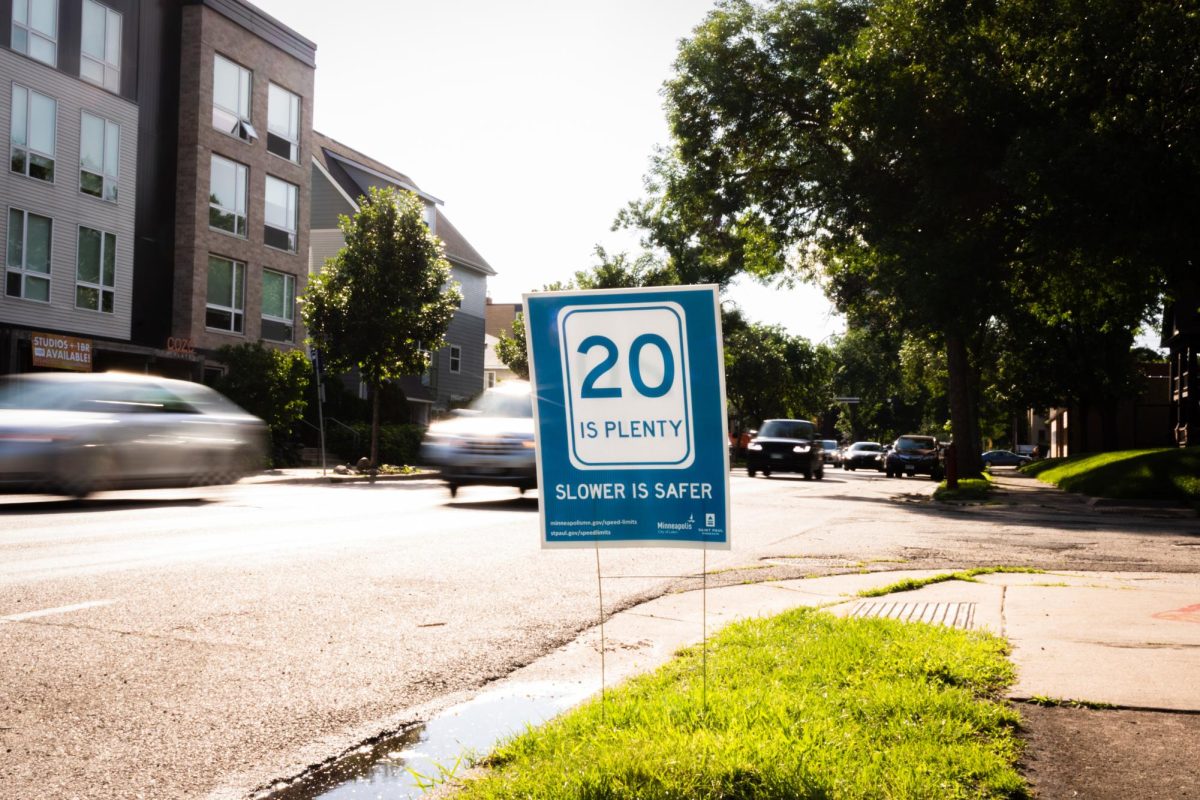Minneapolis has distributed yard signs to raise awareness of slower speed limits in neighborhoods since 2020, but it is just one step toward eliminating pedestrian deaths.
The signs, reading “20 is plenty,” encourage drivers to slow down on residential streets, Ethan Fawley, the Vision Zero program coordinator for Minneapolis, said.
“Traffic speeds are the most important factor in traffic injuries and deaths,” Fawley said.
Minneapolis officially lowered speed limits on residential streets to 20 mph in 2020. With more than 5,000 signs distributed since then, the signs have become very popular, Fawley said.
From 2013 to 2022, there were 272 pedestrian deaths in the Twin Cities metro area, and in 2022, 7,522 people in the U.S. were hit and killed while walking, according to a study conducted by Smart Growth America.
Lower speed limits and other vehicle slowing methods are part of a larger project in Minneapolis, called the Vision Zero Action Plan, which aims to lower pedestrian fatalities to zero in ten years. It originates from a bigger initiative, the Vision Zero Network, which aims to eliminate pedestrian deaths worldwide.
Carly Ellefsen, a spokesperson for Our Streets Minneapolis, an organization in the Twin Cities that promotes safe and equitable street designs, said the city could do more to make streets safer when roads are under construction.
“We aren’t against the ‘20 is plenty’ signage, but to me, it’s interesting that decision-makers are handing them out, because to me it’s a sign they have a lot of work to do,” Ellefsen said.
Narrowing lanes, curve extensions or bump-outs, asphalt art and raised crosswalks are all street designs that force cars to slow down and lower the likelihood of traffic deaths, according to Ellefsen.
“I think a lot of people think Vision Zero isn’t possible, but it is and it’s a traffic engineering and policy choice,” Ellefsen said.
Hoboken, New Jersey is a great example of Vision Zero’s success, Ellefsen added. The city has not had a traffic death in seven years since implementing designs like narrower lanes.
“It’s a really good example of traffic calming measures that prioritize pedestrian safety,” Ellefsen said.
Our Streets Minneapolis has worked to get community members involved and heard in the street planning process, according to Ellefsen.
“It’s hard because often, the decision makers don’t make (community input) easy, and if you’re a working-class person, you don’t often have the time to get engaged,” Ellefsen said.
According to Ellefsen, one way to get involved is by attending street project open houses and other local events. The Our Streets event series, Imagine, aims to get people to celebrate their neighborhoods and get interested in the future design of their streets.
“Honestly, the best (way to get involved) is contacting those decision makers, city council members, mayor and whoever is responsible for the street redesign,” Ellefsen said.
Along with the “20 is plenty” signs, Minneapolis will begin testing out the traffic speed camera pilot, Fawley said.
Set to begin in 2025, the pilot program is designed to discourage speeding by capturing a picture of the license plate on a speeding car and sending the owner a ticket via mail.
Also beginning next year, the city will do a full analysis on the effectiveness of lower speed limits on pedestrian safety in Minneapolis, Fawley said.
According to Ellefsen, ethical traffic engineering in street design prioritizes pedestrian safety.
“People shouldn’t have to beg or take surveys to get these things,” Ellefsen said.








